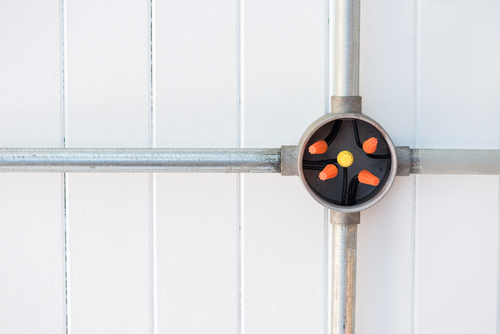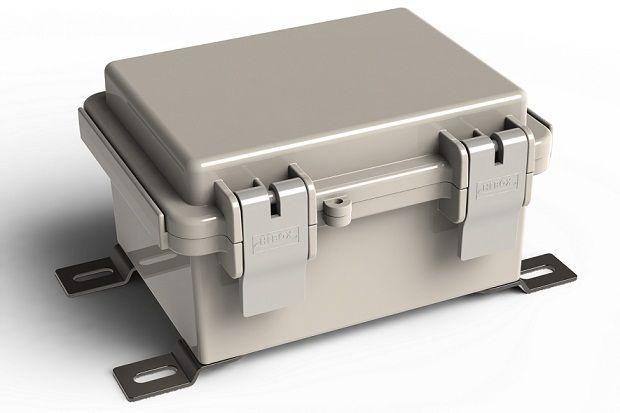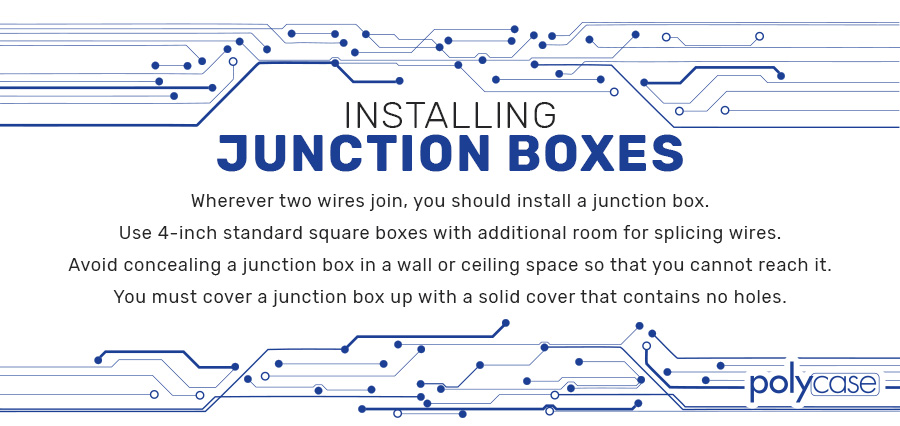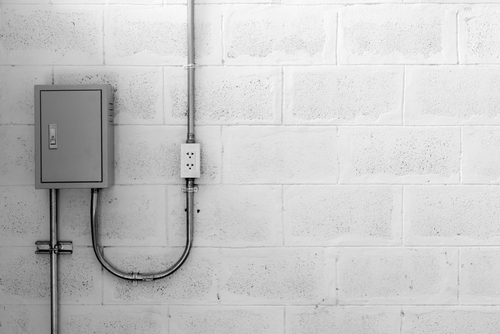August 20, 2018
- Url

 Before you start shopping, you should know what type of case you are looking for and why. Here are a few factors to consider before purchasing an electrical junction box:
Before you start shopping, you should know what type of case you are looking for and why. Here are a few factors to consider before purchasing an electrical junction box:
 Some of the most popular enclosure materials for weatherproof boxes include:
Some of the most popular enclosure materials for weatherproof boxes include: Especially if you are a DIY technician, it’s important to remember that junction boxes have to meet industry standards and building codes in your area. If you can’t install the enclosure on your own, call a professional electrician to do the work for you. It ensures that the job is done right the first time.
Especially if you are a DIY technician, it’s important to remember that junction boxes have to meet industry standards and building codes in your area. If you can’t install the enclosure on your own, call a professional electrician to do the work for you. It ensures that the job is done right the first time. Most boxes are manufactured using either metal or plastic materials. The type of material you use will depend on the application.If you are using a metal conduit to run wiring to a box, then you’ll want to use a metal junction box. That material will help ground the conduit and the wiring. Metal junction boxes are a common choice for electrical panel boxes.For non-metallic materials, such as NM cable and PVC conduit, then you can install a metal or plastic junction box. Make sure that you use a cable clamp to attach the cable to the box. This ensures that it is secure.When rewiring a home or building a new home, you may notice that newer wiring systems contain a ground wire inside the cable. If so, you don’t have to worry about using the box to ground the wiring system, but you’ll still want to connect the box to the ground using a wire.
Most boxes are manufactured using either metal or plastic materials. The type of material you use will depend on the application.If you are using a metal conduit to run wiring to a box, then you’ll want to use a metal junction box. That material will help ground the conduit and the wiring. Metal junction boxes are a common choice for electrical panel boxes.For non-metallic materials, such as NM cable and PVC conduit, then you can install a metal or plastic junction box. Make sure that you use a cable clamp to attach the cable to the box. This ensures that it is secure.When rewiring a home or building a new home, you may notice that newer wiring systems contain a ground wire inside the cable. If so, you don’t have to worry about using the box to ground the wiring system, but you’ll still want to connect the box to the ground using a wire. Round pan boxes are smaller cases – usually ½-inch to ¾-inch deep. Most contractors install them in the ceiling or the wall for light fixtures or smaller objects. The best application is to use them with items that are less than 50 pounds. You can use specific metal pan boxes for implementing ceiling fans, but most models cannot handle heavy weight. Be sure to check the product information before installing.
Round pan boxes are smaller cases – usually ½-inch to ¾-inch deep. Most contractors install them in the ceiling or the wall for light fixtures or smaller objects. The best application is to use them with items that are less than 50 pounds. You can use specific metal pan boxes for implementing ceiling fans, but most models cannot handle heavy weight. Be sure to check the product information before installing. Octagon and round boxes provide a little more flexibility, depending on the size of the case. You’ll usually see these boxes installed in ceilings or walls for light fixtures and ceiling fans up to 50 pounds. If you’re looking for boxes that provide more room for wiring, then round or octagon boxes are perfect for your installation. You can use larger units as junction boxes where needed.If you’re working on a surface-mounted installation that includes a metal conduit, then a round box made of metal is preferred. If you choose a round plastic junction box, you’ll be able to fasten it to the surface using the “ears.” These kinds of junction boxes are perfect for installing the case to drywall or a similar surface. This way, you don’t have to cut a hole to get the job done.
Octagon and round boxes provide a little more flexibility, depending on the size of the case. You’ll usually see these boxes installed in ceilings or walls for light fixtures and ceiling fans up to 50 pounds. If you’re looking for boxes that provide more room for wiring, then round or octagon boxes are perfect for your installation. You can use larger units as junction boxes where needed.If you’re working on a surface-mounted installation that includes a metal conduit, then a round box made of metal is preferred. If you choose a round plastic junction box, you’ll be able to fasten it to the surface using the “ears.” These kinds of junction boxes are perfect for installing the case to drywall or a similar surface. This way, you don’t have to cut a hole to get the job done. Ceiling fan installation requires boxes that can withstand both the weight of the fan and the constant movement of the rotor and blades. Therefore, you will need to use a ceiling fan-rated box, preferably 2-⅛ inches deep. Ceiling fan boxes usually come in round or octagonal shapes. They are designated specifically for ceiling fans so all you have to do is fasten them to a stable surface, like a ceiling joist.Keep in mind that most ceiling fan boxes are rated for supporting fixtures up to 75 pounds. This includes large fans or chandeliers. Remember to account for both the weight of the item and the rotation of the blades when choosing the right box.
Ceiling fan installation requires boxes that can withstand both the weight of the fan and the constant movement of the rotor and blades. Therefore, you will need to use a ceiling fan-rated box, preferably 2-⅛ inches deep. Ceiling fan boxes usually come in round or octagonal shapes. They are designated specifically for ceiling fans so all you have to do is fasten them to a stable surface, like a ceiling joist.Keep in mind that most ceiling fan boxes are rated for supporting fixtures up to 75 pounds. This includes large fans or chandeliers. Remember to account for both the weight of the item and the rotation of the blades when choosing the right box. Standard square boxes are usually 1-¼ inches to 2-⅛ inches deep. Contractors generally use them for multiple connectors or conductors. If you have conductors that are heading in multiple directions, you’ll want to use a square box. You can also use junction boxes or ceiling boxes. The most common application for square boxes is as light switch boxes or electrical outlet boxes. For some applications, a multi-gang box will be necessary for placing multiple connections side by side to house light switches or outlets along the wall.
Standard square boxes are usually 1-¼ inches to 2-⅛ inches deep. Contractors generally use them for multiple connectors or conductors. If you have conductors that are heading in multiple directions, you’ll want to use a square box. You can also use junction boxes or ceiling boxes. The most common application for square boxes is as light switch boxes or electrical outlet boxes. For some applications, a multi-gang box will be necessary for placing multiple connections side by side to house light switches or outlets along the wall.
 The term junction box refers to any box you use as a junction to house electrical connections, like electrical wiring. Junction boxes are square, round or octagonal in shape and can be deep or shallow. When installing these enclosures, adhere to the following guidelines:
The term junction box refers to any box you use as a junction to house electrical connections, like electrical wiring. Junction boxes are square, round or octagonal in shape and can be deep or shallow. When installing these enclosures, adhere to the following guidelines:
 To avoid electrocution or fires, you’ll need to cover the components so that the wires are not exposed. Electronic cases come in a wide range of sizes and shapes so that you can fit them onto any box. The covers are not optional. In fact, they are required to adhere to most building codes. So, make sure all of your boxes are covered up and that all live wires are safely enclosed when your project is complete.Junction boxes require solid covers that contain no holes. That way, no environmental factors, like dust or moisture, can get inside the box.
To avoid electrocution or fires, you’ll need to cover the components so that the wires are not exposed. Electronic cases come in a wide range of sizes and shapes so that you can fit them onto any box. The covers are not optional. In fact, they are required to adhere to most building codes. So, make sure all of your boxes are covered up and that all live wires are safely enclosed when your project is complete.Junction boxes require solid covers that contain no holes. That way, no environmental factors, like dust or moisture, can get inside the box. Sometimes, there will be a gap between the junction box and the drywall or another surface. To close the gap, you can implement a box extender. The extender slides over the opening of the box and you can adjust it as needed to fill in the gap. An enclosed area is safer than leaving the wiring exposed or stretching the wiring beyond the box to reach the wall.Another use for box extenders is to increase the box’s capacity for additional wiring. By using an extender, you can leave an existing box where it is without replacing it. An extender simplifies the job and helps you work more efficiently.
Sometimes, there will be a gap between the junction box and the drywall or another surface. To close the gap, you can implement a box extender. The extender slides over the opening of the box and you can adjust it as needed to fill in the gap. An enclosed area is safer than leaving the wiring exposed or stretching the wiring beyond the box to reach the wall.Another use for box extenders is to increase the box’s capacity for additional wiring. By using an extender, you can leave an existing box where it is without replacing it. An extender simplifies the job and helps you work more efficiently. Waterproof junction boxes are perfect for protecting components from harmful outside elements. These boxes are NEMA (National Electrical Manufacturers Association) or IP-rated (Ingress Protection) to withstand certain weather conditions such as UV rays, extreme heat or cold, high winds and moisture.
Waterproof junction boxes are perfect for protecting components from harmful outside elements. These boxes are NEMA (National Electrical Manufacturers Association) or IP-rated (Ingress Protection) to withstand certain weather conditions such as UV rays, extreme heat or cold, high winds and moisture. You will need a waterproof junction box in wet or damp locations, as water is the most significant threat to electronic devices and components. When installing the waterproof junction box, make sure that it is tightly sealed. When choosing an enclosure, make sure you check the NEMA and IP rating. They will specify that box is adequate, depending on your application and environmental factors.
You will need a waterproof junction box in wet or damp locations, as water is the most significant threat to electronic devices and components. When installing the waterproof junction box, make sure that it is tightly sealed. When choosing an enclosure, make sure you check the NEMA and IP rating. They will specify that box is adequate, depending on your application and environmental factors. If you use the right electronic enclosures, then your components will be protected and secure at all times. When choosing the right case, always consider the specific needs associated with inside and outside applications. Then, select the right material — such as metal or plastic — based on environmental factors. Once you find the right electronic box, you can rest assured that your hard-working investment will be safe for years to come!
If you use the right electronic enclosures, then your components will be protected and secure at all times. When choosing the right case, always consider the specific needs associated with inside and outside applications. Then, select the right material — such as metal or plastic — based on environmental factors. Once you find the right electronic box, you can rest assured that your hard-working investment will be safe for years to come!